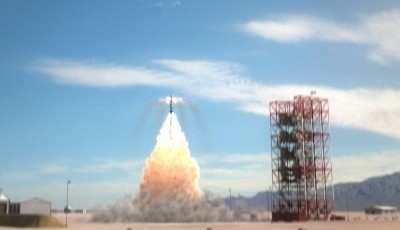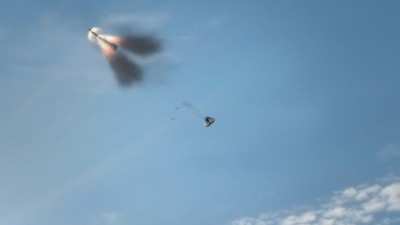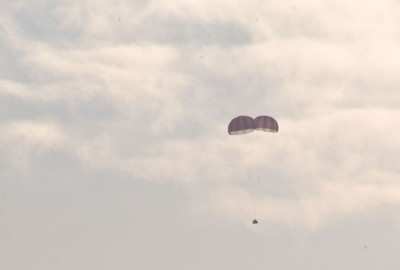Would Pull Crew To Safety In The Event Of A Launch Pad
Emergency
Potential major changes in the NASA budget not withstanding,
NASA's Pad Abort 1 flight test, a launch of the abort system
designed for the Orion crew vehicle, lifted off at 0700 MDT
Thursday at the U.S. Army's White Sands Missile Range (WSMR) near
Las Cruces, NM. The flight lasted about 135 seconds from launch
until the crew module touchdown about a mile north of the launch
pad.

NASA Photo
The flight was the first fully-integrated test of this launch
abort system design. The information gathered from the test will
help refine design and analysis for future launch abort systems,
resulting in safer and more reliable crew escape capability during
rocket launch emergencies.
"Through hard work and incredible dedication over the past
several years, the Orion Pad Abort 1 team has successfully tested
the first U.S. designed abort system since Apollo," said Doug
Cooke, associate administrator for the Exploration Systems Mission
Directorate at NASA Headquarters in Washington. "This system is
much more advanced in capability and technology than any abort
system designed in the past. NASA strives to make human spaceflight
as safe as possible, and what we learned here today will greatly
contribute to that goal."

NASA Artist's Concept
The test involved three motors. An abort motor produced a
momentary half-million pounds of thrust to propel the crew module
away from the pad. It burned for approximately six seconds, with
the highest impulse in the first 2.5 seconds. The crew module
reached a speed of approximately 445 mph in the first three
seconds, with a maximum velocity of 539 mph, in its upward
trajectory to about 1.2 miles high.
The attitude control motor fired simultaneously with the abort
motor and steered the vehicle using eight thrusters producing up to
7,000 pounds of thrust. It provided adjustable thrust to keep the
crew module on a controlled flight path and reorient the vehicle as
the abort system burned out.

NASA Artist's Concept
The jettison motor, the only motor of the three that would be
used in all nominal rocket launches, pulled the entire launch abort
system away from the crew module and cleared the way for parachute
deployment and landing. After explosive bolts fired and the
jettison motor separated the system from the crew module, the
recovery parachute system deployed. The parachutes guided the crew
module to touchdown at 16.2 mph (24 feet per second), about one
mile from the launch pad.

NASA Photo
The Orion Project has begun the process of recovering all of the
test articles from the WSMR range and will be evaluating all of the
data over the coming weeks.
The Orion Project office at NASA's Johnson Space Center in
Houston led the launch abort system test team. System development
is led by NASA's Langley Research Center in Hampton, VA, in
partnership with NASA's Marshall Space Flight Center in Huntsville,
Ala. Langley designed and produced the boilerplate crew module for
the flight test.
 Classic Aero-TV: Remembering Bob Hoover
Classic Aero-TV: Remembering Bob Hoover ANN FAQ: Follow Us On Instagram!
ANN FAQ: Follow Us On Instagram! ANN's Daily Aero-Linx (05.15.24)
ANN's Daily Aero-Linx (05.15.24) ANN's Daily Aero-Term (05.15.24):Altimeter Setting
ANN's Daily Aero-Term (05.15.24):Altimeter Setting Aero-News: Quote of the Day (05.16.24)
Aero-News: Quote of the Day (05.16.24)






